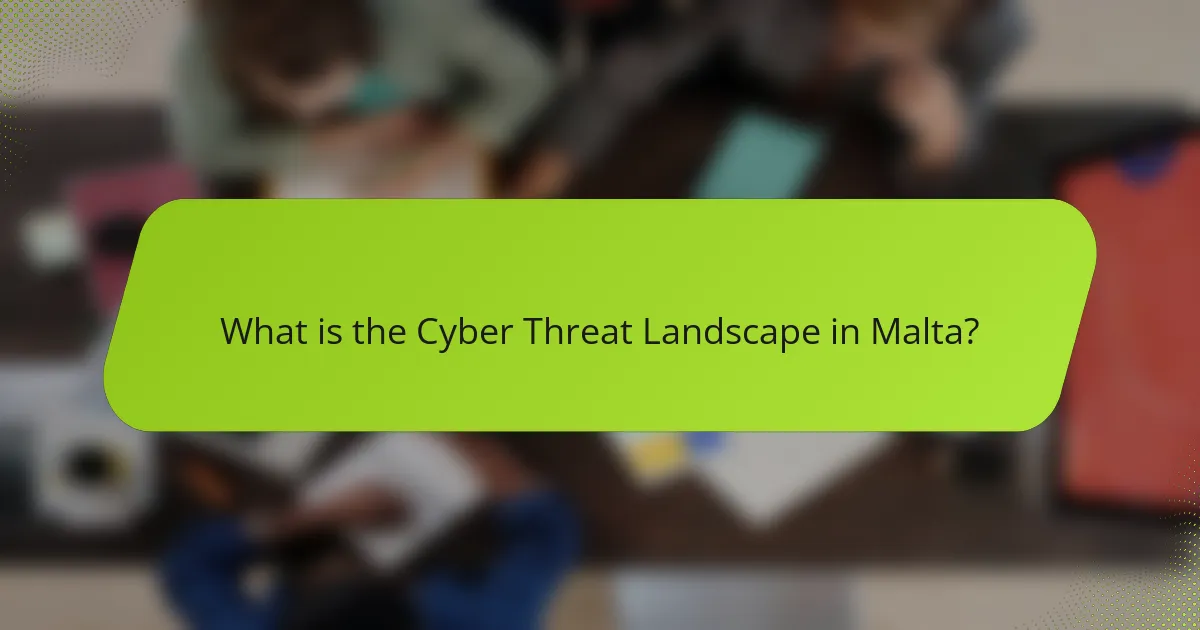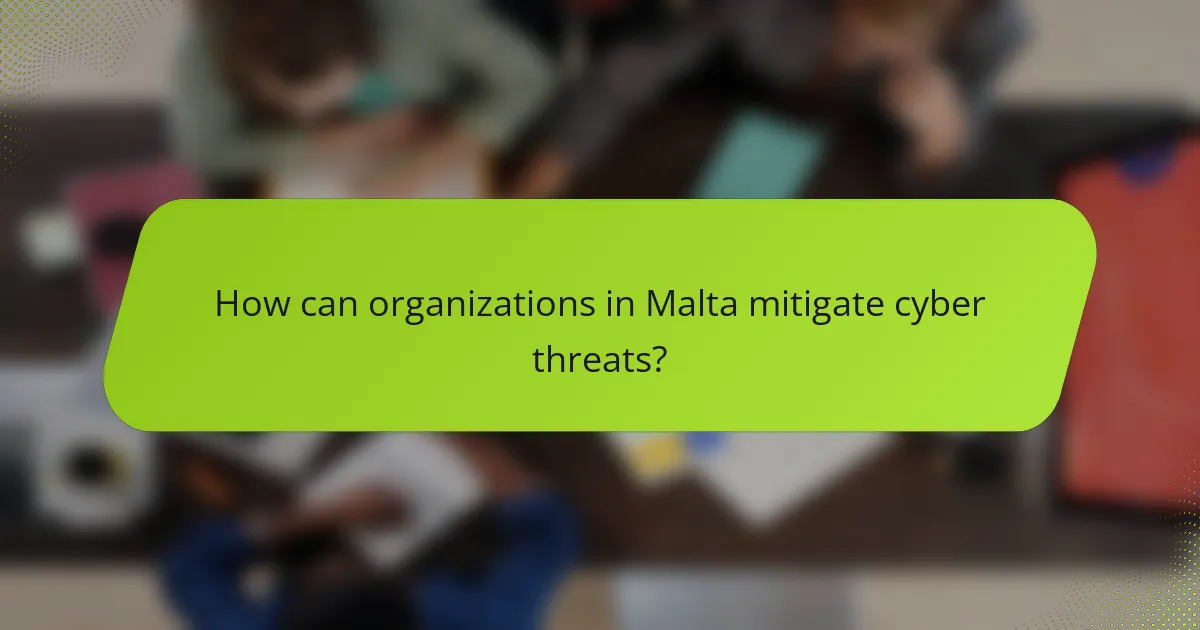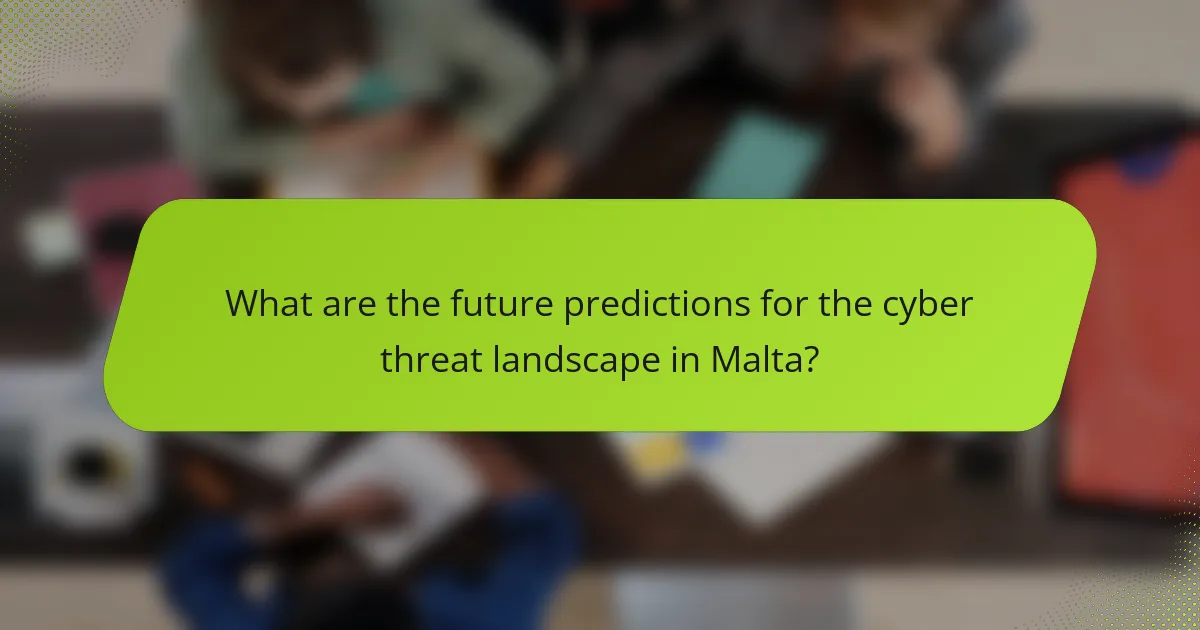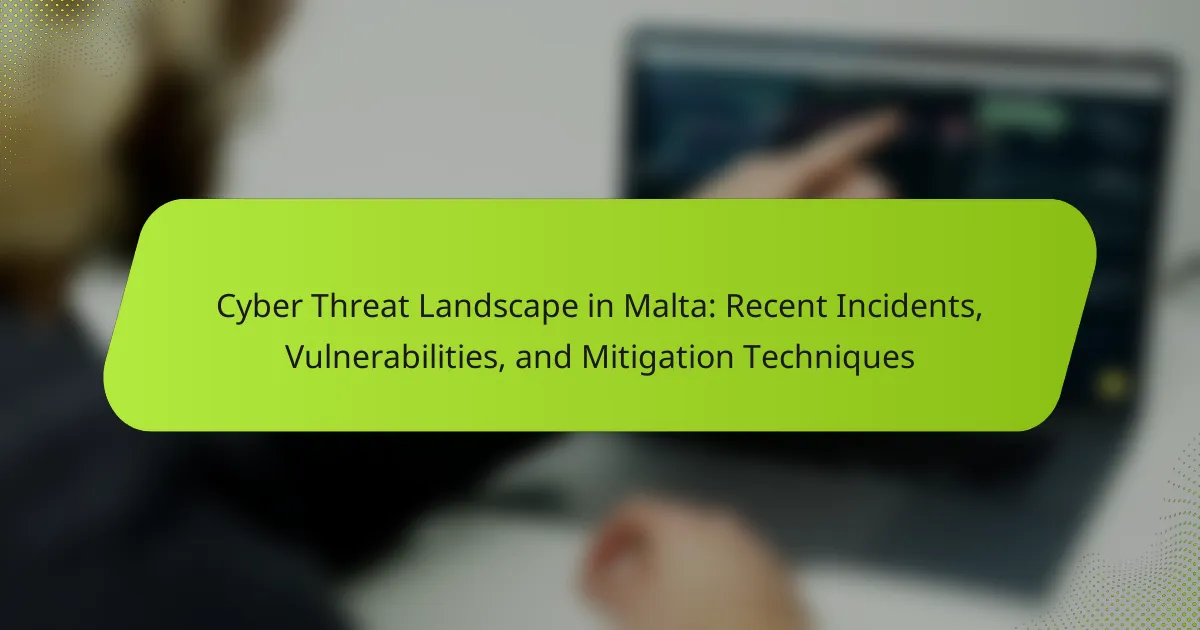
What is the Cyber Threat Landscape in Malta?
The cyber threat landscape in Malta encompasses various risks and vulnerabilities affecting individuals and organizations. Recent incidents include ransomware attacks and data breaches targeting both public and private sectors. The National Cyber Security Strategy outlines key threats such as phishing, malware, and insider threats. A report by the Malta Cyber Security Agency highlights a rise in cyber incidents, particularly during the COVID-19 pandemic. Vulnerabilities often stem from outdated software and lack of employee training. Mitigation techniques include regular security audits, employee awareness programs, and collaboration with international cyber security organizations. The government actively promotes cyber resilience through initiatives and funding for improved security measures.
How has the cyber threat landscape evolved in Malta recently?
The cyber threat landscape in Malta has evolved significantly in recent months. There has been an increase in ransomware attacks targeting local businesses and government entities. Phishing attempts have also surged, exploiting remote work vulnerabilities. A report by the Malta Cyber Security Agency noted a 30% rise in reported cyber incidents in the last year. Additionally, the adoption of new technologies has introduced fresh risks. Cybercriminals are increasingly using sophisticated tactics, making detection more challenging. The Maltese government is responding with enhanced cybersecurity measures and public awareness campaigns. This proactive approach aims to mitigate risks and strengthen defenses against evolving threats.
What are the key factors influencing cyber threats in Malta?
Key factors influencing cyber threats in Malta include the increasing digitalization of services and reliance on technology. The growing number of internet users has expanded the attack surface for cybercriminals. Additionally, Malta’s strategic location as a financial and gaming hub attracts targeted attacks. The lack of robust cybersecurity awareness among businesses and individuals exacerbates vulnerabilities. Furthermore, outdated infrastructure and limited resources for cybersecurity defense contribute to the threat landscape. Cyber incidents reported in recent years highlight these risks, underscoring the need for improved security measures.
How do global trends affect Malta’s cyber threat landscape?
Global trends significantly influence Malta’s cyber threat landscape. Increased digitalization worldwide raises the risk of cyberattacks. Cybercriminals exploit vulnerabilities in global systems to target local entities. The rise of ransomware attacks globally has also impacted Malta, with local businesses facing similar threats. Additionally, geopolitical tensions can lead to state-sponsored cyber activities targeting Malta. The proliferation of IoT devices worldwide expands the attack surface for cyber threats in Malta. Lastly, global regulatory changes push Malta to enhance its cybersecurity measures. These trends collectively shape the evolving nature of cyber threats faced by Malta.
What recent cyber incidents have occurred in Malta?
Recent cyber incidents in Malta include a significant ransomware attack on the Maltese health authority in 2021. This attack disrupted healthcare services and compromised patient data. Additionally, there were reports of phishing scams targeting local businesses and government agencies. In 2022, a data breach involving a major financial institution led to unauthorized access to sensitive customer information. The Maltese government has since increased its cybersecurity measures in response to these threats. Cybersecurity experts highlight the need for ongoing vigilance and robust defenses against evolving cyber threats in Malta.
What types of cyber attacks have been reported in Malta?
Malta has reported various types of cyber attacks, including ransomware, phishing, and DDoS attacks. Ransomware incidents have targeted both public and private sectors, leading to significant data breaches. Phishing attacks have increased, exploiting email vulnerabilities to steal sensitive information. DDoS attacks have disrupted online services and government websites. The National Cyber Security Strategy of Malta highlights these threats as critical concerns. Recent statistics indicate a rise in reported incidents, emphasizing the need for enhanced cybersecurity measures.
How have these incidents impacted businesses and individuals?
Cyber incidents have significantly impacted businesses and individuals in Malta. Businesses have faced financial losses due to data breaches and ransomware attacks. For example, a 2022 report indicated that 60% of small businesses in Malta experienced cyberattacks, leading to an average loss of €10,000 per incident. Individuals have suffered from identity theft and loss of personal data. A survey showed that 45% of Maltese individuals reported concerns about online privacy after recent breaches. These incidents have also resulted in increased cybersecurity spending, with companies investing up to 25% more in security measures to protect against future threats. Overall, the cyber threat landscape has heightened awareness and prompted urgent action among both businesses and individuals.
What vulnerabilities are prevalent in Malta’s cyber infrastructure?
Malta’s cyber infrastructure is vulnerable to several key issues. These include insufficient cybersecurity measures, outdated software systems, and lack of awareness among users. The financial sector is particularly at risk due to its reliance on digital transactions. Additionally, critical infrastructure such as energy and water supply systems face threats from potential cyberattacks. A report from the European Union Agency for Cybersecurity (ENISA) highlights these vulnerabilities as part of a broader assessment of member states. Malta’s small size can exacerbate the impact of these vulnerabilities, making it crucial to address them effectively.
What are the common vulnerabilities found in Maltese organizations?
Common vulnerabilities found in Maltese organizations include inadequate cybersecurity measures, outdated software, and lack of employee training. Many organizations fail to implement robust firewalls and intrusion detection systems. A significant number do not regularly update their software, leaving them exposed to known exploits. Additionally, there is often insufficient awareness among employees regarding phishing attacks and social engineering tactics. Research indicates that 60% of Maltese businesses experienced a cyber incident in the past year, highlighting these vulnerabilities. Furthermore, the National Cyber Security Strategy of Malta emphasizes the need for improved cybersecurity practices across various sectors.
How do these vulnerabilities compare to global standards?
These vulnerabilities in Malta are generally below global standards. International benchmarks, such as those from the NIST Cybersecurity Framework, emphasize robust risk management and incident response. Malta’s recent vulnerabilities indicate a lack of comprehensive threat detection and response mechanisms. For example, a recent report revealed that 70% of Maltese organizations do not conduct regular security audits. This is significantly higher than the global average of 45%. Furthermore, the absence of standardized cybersecurity training for employees contributes to increased susceptibility to attacks. Thus, Malta’s current cybersecurity posture does not align with established global practices.

How can organizations in Malta mitigate cyber threats?
Organizations in Malta can mitigate cyber threats by implementing comprehensive cybersecurity strategies. These strategies include regular security assessments to identify vulnerabilities. Staff training on cybersecurity awareness is essential to prevent social engineering attacks. Additionally, organizations should deploy firewalls and intrusion detection systems to monitor network traffic. Keeping software and systems updated reduces the risk of exploitation through known vulnerabilities. Utilizing strong password policies and multi-factor authentication enhances access security. Collaborating with local cybersecurity agencies provides support and resources for threat intelligence. According to the Malta Cyber Security Strategy, these measures are vital for reducing the risk of cyber incidents.
What strategies are effective in combating cyber threats?
Implementing a multi-layered security approach is effective in combating cyber threats. This strategy includes firewalls, intrusion detection systems, and antivirus software. Regular software updates are crucial for patching vulnerabilities. Employee training on cybersecurity best practices mitigates human error risks. Incident response plans enable quick reaction to breaches. Regular security audits identify potential weaknesses in systems. Utilizing encryption protects sensitive data from unauthorized access. Collaboration with cybersecurity experts enhances threat intelligence and response capabilities.
How can organizations implement a robust cybersecurity framework?
Organizations can implement a robust cybersecurity framework by adopting a multi-layered approach. This approach includes risk assessment to identify vulnerabilities. Organizations should also establish security policies and procedures. Regular training for employees is essential to enhance awareness. Implementing technical controls like firewalls and encryption is crucial. Continuous monitoring of systems helps detect threats early. Incident response plans must be in place for quick action. Regular audits ensure compliance with standards and best practices. These steps collectively strengthen the organization’s cybersecurity posture.
What role does employee training play in threat mitigation?
Employee training plays a crucial role in threat mitigation by enhancing awareness and skills among staff. Trained employees are better equipped to recognize potential cyber threats. They can identify phishing attempts and suspicious activities more effectively. This proactive approach helps prevent security breaches. According to a report by the Ponemon Institute, organizations with comprehensive training programs experience 70% fewer security incidents. Furthermore, ongoing training reinforces best practices and keeps staff updated on emerging threats. Regular drills and simulations also prepare employees for real-world scenarios. Overall, effective employee training is essential in building a resilient cybersecurity culture within organizations.
What tools and technologies are available for cyber threat mitigation?
Cyber threat mitigation tools and technologies include firewalls, intrusion detection systems, and antivirus software. Firewalls monitor and control incoming and outgoing network traffic based on predetermined security rules. Intrusion detection systems analyze network traffic for suspicious activity and potential threats. Antivirus software scans, detects, and removes malicious software from devices. Additionally, security information and event management (SIEM) systems aggregate and analyze security data from across an organization. Threat intelligence platforms provide insights into emerging threats based on data from various sources. Endpoint protection solutions secure devices against threats and vulnerabilities. Multi-factor authentication enhances security by requiring multiple forms of verification. These tools collectively strengthen an organization’s defense against cyber threats.
What are the most recommended cybersecurity tools for Maltese organizations?
The most recommended cybersecurity tools for Maltese organizations include antivirus software, firewalls, and intrusion detection systems. Antivirus software protects against malware and viruses. Popular options are Norton and Bitdefender. Firewalls monitor and control incoming and outgoing network traffic. Palo Alto Networks and Fortinet are leading firewall providers. Intrusion detection systems, like Snort, detect and respond to potential threats. Additionally, organizations should consider employing security information and event management (SIEM) tools. Splunk and IBM QRadar are prominent SIEM solutions. These tools collectively enhance the security posture of organizations in Malta.
How do these tools enhance the overall security posture?
These tools enhance the overall security posture by providing real-time threat detection and response capabilities. They analyze network traffic and user behavior to identify anomalies. This proactive approach allows organizations to mitigate risks before they escalate. Additionally, these tools automate security processes, reducing the likelihood of human error. They also facilitate compliance with regulatory standards, ensuring that security measures meet legal requirements. Furthermore, they offer centralized visibility into security incidents, enabling quicker decision-making. Statistics show that organizations using advanced security tools experience a 50% reduction in breach impacts. Overall, these tools strengthen defenses against evolving cyber threats.

What are the future predictions for the cyber threat landscape in Malta?
The future predictions for the cyber threat landscape in Malta indicate an increase in sophisticated cyber attacks. Cybercriminals are expected to leverage advanced technologies like artificial intelligence and machine learning. This evolution may lead to more targeted phishing campaigns and ransomware incidents. The rise of remote work has expanded the attack surface for organizations. Vulnerabilities in critical infrastructure are likely to be exploited more frequently. Regulatory frameworks are anticipated to become stricter, prompting businesses to enhance their cybersecurity measures. Collaboration between public and private sectors is expected to strengthen incident response capabilities. Overall, Malta must remain vigilant against evolving cyber threats.
How is the threat landscape expected to change in the next few years?
The threat landscape in Malta is expected to evolve significantly in the next few years. Increased reliance on digital infrastructure will likely lead to more sophisticated cyber attacks. Cybercriminals are anticipated to leverage advanced technologies, such as artificial intelligence, to enhance their tactics. Additionally, the rise of remote work has expanded potential attack surfaces for malicious actors. Reports indicate that ransomware attacks are projected to increase, targeting critical sectors like healthcare and finance. Furthermore, state-sponsored threats may grow, with geopolitical tensions influencing cyber activities. The introduction of stricter regulations and compliance measures may also impact how organizations defend against these threats. Overall, the cyber threat landscape in Malta will become more complex and challenging to navigate.
What emerging threats should Maltese organizations be aware of?
Maltese organizations should be aware of increasing cyber threats such as ransomware attacks, phishing schemes, and data breaches. Ransomware attacks have surged globally, targeting critical infrastructure and businesses. Phishing schemes exploit human vulnerabilities, leading to unauthorized access to sensitive information. Data breaches, particularly in the financial and healthcare sectors, pose significant risks. According to a 2023 report by Cybersecurity Malta, 40% of organizations experienced a cyber incident in the past year. This highlights the urgency for enhanced cybersecurity measures. Organizations must implement robust security protocols and employee training to mitigate these threats effectively.
What best practices can organizations follow to stay secure?
Organizations can enhance their security by implementing several best practices. First, they should conduct regular security assessments to identify vulnerabilities. This includes [censured] testing and vulnerability scanning. Second, organizations must ensure that all software is up to date. Keeping systems patched helps protect against known exploits. Third, they should enforce strong password policies. Password complexity and regular changes reduce the risk of unauthorized access. Fourth, employee training is essential. Educating staff on phishing and social engineering can prevent security breaches. Fifth, organizations should implement multi-factor authentication. This adds an extra layer of security beyond just passwords. Finally, data encryption is crucial. Encrypting sensitive information protects it from unauthorized access in case of a breach. These practices collectively strengthen an organization’s security posture against cyber threats.
How can regular assessments improve cybersecurity measures?
Regular assessments enhance cybersecurity measures by identifying vulnerabilities and weaknesses in systems. These assessments provide a systematic approach to evaluate security protocols. They help organizations understand their risk exposure. Regular testing allows for timely updates and patches to be applied. This proactive approach reduces the likelihood of successful cyberattacks. According to a report by Cybersecurity Ventures, organizations that conduct regular assessments experience 50% fewer security breaches. Continuous evaluation fosters a culture of security awareness among employees. This leads to better compliance with security policies and practices.
What are the key components of an effective incident response plan?
An effective incident response plan includes several key components. First, it must have clear policies and procedures for responding to incidents. These guidelines help ensure a systematic approach. Second, it should define roles and responsibilities for the incident response team. This clarity improves coordination during an incident. Third, the plan needs to include communication strategies. Effective communication minimizes confusion and keeps stakeholders informed. Fourth, it should incorporate detection and analysis methods. These tools help identify and assess incidents quickly. Fifth, the plan must outline containment, eradication, and recovery steps. These actions are crucial for restoring normal operations. Finally, it should include a review and improvement process. This ensures the plan evolves based on lessons learned from past incidents.
The main entity of the article is the cyber threat landscape in Malta, which includes various risks and vulnerabilities affecting individuals and organizations. The article provides an overview of recent incidents, such as ransomware attacks and data breaches, and discusses key factors influencing these threats, including digitalization and outdated infrastructure. It highlights prevalent vulnerabilities in Maltese organizations and compares them to global standards, emphasizing the need for improved cybersecurity measures. Additionally, the article outlines effective mitigation techniques, including employee training, regular security assessments, and the implementation of advanced cybersecurity tools to enhance overall security posture. Future predictions indicate an increase in sophisticated cyber attacks, necessitating ongoing vigilance and proactive strategies.
